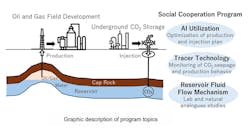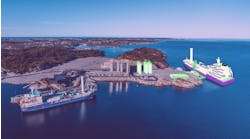Hydrogen presents opportunities but also poses challenges
Martin Van Sickels, Endeavor Management
Bruce Crager, Endeavor Management
The drive for decarbonization has created an interest in hydrogen because it produces only water when it burns and no carbon dioxide. Thus, hydrogen is environmentally friendly, if managed correctly. It is as abundant on earth as water or combined with hydrocarbons, but unfortunately, generally not in the free state (not naturally occurring).
For the offshore market, hydrogen projects introduce another level of complexity and risk. Hydrogen production, powered by offshore wind power generation, favors the electrolysis production route.
Keeping up with the rapidly developing activities in the hydrogen area is a significant challenge. Contributing to the challenge is that plant capacities are often quoted in different units. Historically, hydrogen plant capacity units were millons of standard cubic feet per day (MM SCFD) or thousands of normal cubic meters per hour (M Nm3/hr) whereas today the more commonly quoted units are either metric tons day (MTPD) or, in the case of electrolysis-based plants, megawatts (MW). The table presented in this article has been developed to help with this unit problem.
How hydrogen is manufactured is often described in as many as nine colors. At present, the two most common are green or blue. Green hydrogen is made via either alkaline or proton exchange membrane (PEM) electrolysis of water using green power, primarily from wind and solar. Blue hydrogen is made either via steam reforming or autothermal reforming (ATR) or partial oxidation (POX) of hydrocarbons – generally natural gas, with CO2 capture.
In addition, there is considerable development activity with turquoise hydrogen via pyrolysis (cracking) of natural gas into hydrogen and carbon; and with gold hydrogen, naturally occurring hydrogen gas, but these potential resources are yet to be proven in significant quantities.
When considering investing in a hydrogen project, there are several risk factors which can be equally important and often interrelated, that must be addressed to assure project and investment success. They fall into four broad categories: technology, location, regulatory/environmental, and financial.
With respect to technology, the alkaline electrolysis of water route has been in commercial practice in small plants for many years and is the cheapest electrolysis route. PEM electrolysis is a more recent development and began to be sold commercially in the 1960s. The choice between the two is dependent on their application as both have the potential to be used at gigawatt scale. The largest alkaline hydrogen electrolyzer is 30 MW (~5.9 MM SCFD) operated by Baofeng Energy in China and the largest PEM based plant is 20 MW (~3.3 MM SCFD) operated by Air Liquide in Canada.
To put electrolytic hydrogen in perspective with alternate production methods, there are hundreds of large-scale, >100 MM SCFD, single-train, steam-reforming units in existing refineries, ammonia and methanol plants, and numerous ATR and POX-based plants, some with very large capacities, e.g., 450 MM SCFD. Commonly these plants capture the CO2 produced on the process side to reach the hydrogen purity needed, but it is often vented to the atmosphere. The exception is ammonia plants where CO2 is often reacted with ammonia and converted to urea. A limited few send their captured CO2 to storage or to enhanced oil recovery. There is no technical scale-up risk with blue hydrogen.
The location of the hydrogen plant will have considerable impact on both its capex and opex. Key factors that need to be addressed are proximity to feedstock, utility needs (e.g. water, green power), end user(s), CO2 sequestration location (if needed), hydrogen end user proximity, onshore or offshore, and pipeline needs.
Pipeline needs can be complex and include e.g. natural feed gas pipeline if blue, CO2 pipeline to sequestration location; H2 pipeline – dedicated, blended, existing, new, materials of construction, retrofit requirements; H2 leakage; dedicated end users or to the grid and right-away needs.
For regulatory and environmental issues permitting requirements can be quite complex, time-consuming and require considerable engineering support. The cost of these activities needs to be realistically estimated for impact both on the project schedule and cost. To make them economically viable, almost all green and blue hydrogen projects require government subsidies (loan guarantees and tax credits). Plant designs and corresponding capex and opex estimates must reflect these subsidies.
Other factors to be addressed include: 1. The total cost of the project estimate needs to reflect all costs such as third party and owner’s costs, 2. Realism of the project schedule from the preliminary design phase to full commercial operation, 3. Realistic assessment of the total contingency needed, 4. Realistic estimate of the timing of project expenditures, etc. The effort and its cost to reach the final investment decision (FID) will be considerable and needs to be realistically funded.
To achieve fundability, a front-end engineering design (FEED) package engineering and accompanying capex estimate must be developed that reflects all of the client's project-specific requirements and avoids significant changes during the project execution phase. The production of a quality FEED is costly, requiring about 20% of the total project’s engineering effort, and often takes a year to produce.
For the offshore market, two basic concepts are being developed. Hydrogen produced offshore on a central platform and hydrogen produced via an electrolyzer integrated with each wind turbine and piped to a collection grid then to onshore. The centralized approach can be done either on a repurposed platform where the hydrogen produced will be transported to shore via a dedicated existing pipeline or on a new build platform with a new pipeline, both supplied with electric power from either new or existing nearby wind turbine generators.
Both concepts require seawater desalination to supply fresh water to the electrolyzers. Unfortunately, the electrolysis of seawater to produce hydrogen is still in the research and pilot stage of development. Thus, in the near-term, seawater desalination will be required along with freshwater storage and a supply of electrical energy to operate the system. If an existing pipeline is to be used, the metallurgy will need to be sufficient to resist hydrogen attack.
Unlike most land applications, use of available platform real estate will be a challenge, particularly with repurposed ones. One of the key questions to be answered is: Does the platform have sufficient space available to produce an economically viable amount of hydrogen? Safety is very important offshore due to the need for a compact design. Hydrogen has a small molecular size, about 1/3 that of methane, and thus the small molecules will find every opportunity to leak. Hydrogen has a much lower ignition temperature than methane: 952°F vs. 1076°F and has a much wider range of flammability in air of 4% to 74% vs. 5% to 15% for methane.
Not to be overlooked is the likely increased opex compared to an onshore operation due to factors such as location, maintenance in a harsh environment, and the need for a compact design.
At present there are no commercial offshore hydrogen projects. Two example pilot projects are the centralized concept used by Lhfye, a 1 MW floating platform off France, and the integrated wind turbine electrolyzer concept used by Dolphyn, a 100-220 kW project off Wales. Both projects propose to advance to the commercial stage after successful pilot testing. Endeavor Management is a lead collaborator on a DOE-funded, University of Houston-led study exploring repurposing GOM infrastructure to produce green hydrogen on refurbished platforms. A future article will discuss this initiative and learnings to date.
Whether located onshore or offshore, whether green or blue hydrogen, proposed projects face some common hurdles to gain financing for early-stage, commercial projects. Examples are: getting the costly funding needed to develop a project to the point where is can be financed, status of technical development and economy of scale, geographic constraints, having a buyer willing to make long-term purchase commitments for a premium-priced product, and qualifying for both government loan guarantees and tax credits. While there are many hydrogen projects announced, few will overcome these hurdles, at least in the near term.






